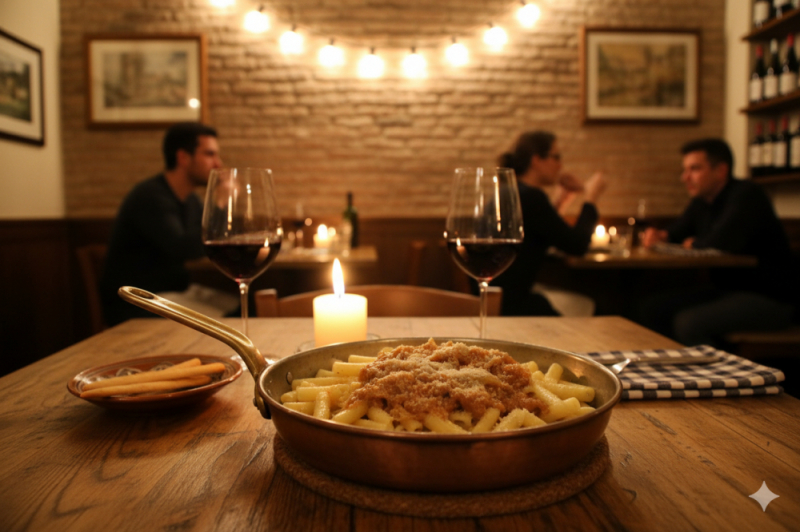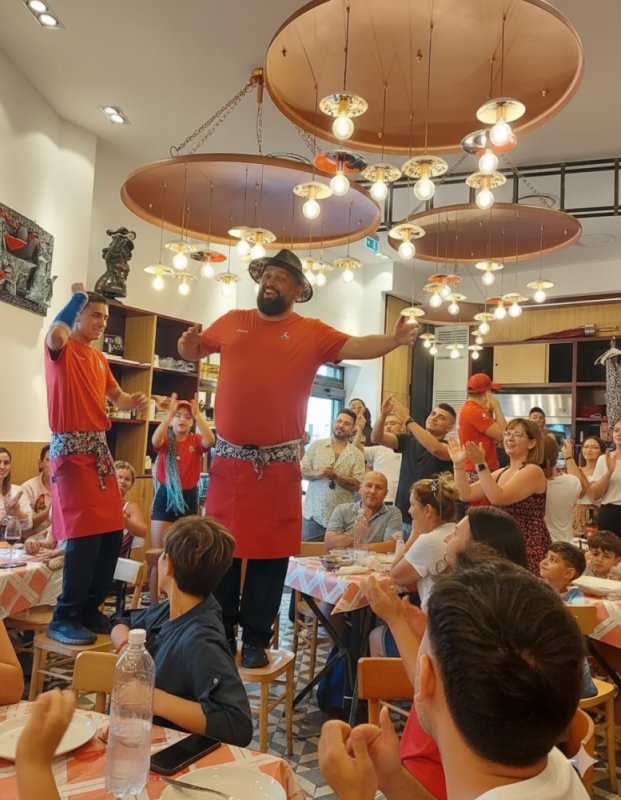Naples capital of taste: history, tradition and international awards
Naples is inextricably linked to its history and culture, which together with its dominations, have created the heritage of Neapolitan worship and good food. Naples is the historic center, full of monuments, but it is also the place where the traditional art of Neapolitan pizza maker was born, now recognized as a UNESCO World Heritage Site (year 2024 - read at this link).
The international magazine Time Out (year 2024 - read at this link) and the newspaper La Repubblica (year 2024 - read at this link), have reported the news that Naples has been classified as the city with the best food in the world. The articles underline that this recognition is not only due to starred restaurants, but above all to the strength of home cooking, taverns and authentic street food. Here the restaurants did not start looking for new flavors, cooking techniques, seaweed and rare raw materials, in more or less risky combinations, but they started again from ancient recipes, from the flavors of Sunday to grandmothers' lunches
.
From “See Naples and then Die, we have moved on to “See Naples and then eat”, with exhibitions promoted by the City of Naples where food is used as a key to understanding the history, art and identity of the city through show cooking, tastings and guided itineraries. “The Guardian” highlights the city's culinary excellence as a fundamental part of daily life, rather than a luxury. "The New York Times” often focuses on the traditional art of Neapolitan pizza, noting its cultural meaning and meticulous attention to ingredients, while “CNN Travel” and “Eater” present the vibrant street food scene and offer guides to places offering tradition and innovation (see also our guide on street food in Naples).
3 Neapolitan first courses to try: Pasta and potatoes with provola cheese, La Genovese, Ziti with Neapolitan ragù
As Neapolitans as we are, we are well aware that food is a serious thing in Naples, and that is why we would like to guide you on a journey through the 5 most iconic dishes in Naples, absolutely not to be missed, explaining its history, the tradition behind it, the recipe, but above all, advising you where to eat them.
So let's start with 3 firsts that you absolutely can't help but lie when you're in Naples:
- Pasta and Potatoes with Provola cheese - poor traditional Neapolitan dish based on a sauté of carrot, celery and onion, extra virgin olive oil then the addition of potatoes in chunks cooked until creamy and finally strictly mixed pasta (cooked in potatoes and not separately, for those who want to replicate the recipe at home... I recommend!). Brought to the limelight thanks to Ciro della Trattoria Nennella with his videos on Tik Tok. Innovation: here at Nennella, with respect to tradition, pasta and potatoes have met “provola” (smoked “fior di latte”) that transforms it from a traditional dish into an iconic Neapolitan dish. Curiosity: “mixed” pasta is a typical Campanian pasta that was born as pasta for the poor, recycled, in fact it was made from all the pieces of pasta broken during transport in crates
of different formats.
- "La Genovese”: this dish, despite the name that evokes the city of Genoa, is absolutely a dish born in Naples, which can only be tasted in Naples, which is part of the Neapolitan culinary tradition. Legend has it that it was born in a trattoria near the port and that it probably takes its name from the cook who, having Genoese origin, was commonly called 'O Genovese, to the point of identifying the name of the chef with the name of the dish. The recipe is very simple and is a stew of abundant onions (here the “ramata” of Montoro is used) and meat, which go on to season an excellent dish of pasta al dente, topped with a large handful of Parmesan (or pecorino) for those who like it.
- “Ziti al Ragù”: this is the traditional dish par excellence. Top authorities, intellectuals, writers such as Eduardo De Filippo and iconic films have taken the time to talk about this Neapolitan Sunday dish. If you want, for example, to make two women from different neighborhoods fight, ask what the REAL recipe for ragù is. They will answer you that each neighborhood has its own and each one is the real one. The truth is that every grandmother cooked her own, according to her economic possibilities and tastes, but in any case every recipe is made from a base of onion sauté, many types of beef, pork and, in order not to miss anything, even meatballs, sausages, chops (rolls with pepper, pecorino cheese, raisins and pine nuts), all cooked “pappuliando” (simmering) in plenty of tomato sauce for at least 8 hours. Once seasoned with lard (pork fat), while today with extra virgin oil, it would like, by tradition, to be cooked in earthen pots. On Sundays, always in respect of tradition, grandmothers would make the little ones break the ziti (long pasta shaped like candles) which they then cooked and seasoned with burnt red tomato sauce with a very intense flavor (never forgotten by those who have tasted it at least once), then accompanied by some of the meat that had been cooked in the tomato.
2 iconic second courses in Naples: Meatballs with sauce, Holy Thursday mussel soup
and here are 2 seconds that are the most popular:
- Meatballs with sauce: this is another dish of poor cuisine in Naples, made with stale bread, minced meat, eggs, cheese, parsley and garlic. A poor and recoverable recipe, but also a deception, because once meat cost too much to afford it and therefore the meatballs were made almost entirely of stale bread, soaked in water to soften it. But despite being a recovery dish, fried foods become a sublime thing, but above all, cooked in Sunday ragù, they become a real experience not to forget, indeed to be repeated often. Here the shoe with the sauce is
a must.
- Mussel soup: for the origins of this recipe, we have to bother Ferdinando I of Bourbon, a well-known lover of fish recipes, and the traditions of the Catholic religion that wants meat not to be eaten on Holy Thursday. In fact, this dish, wanted precisely by King Ferdinand for Holy Thursday, has become the popular recipe cooked by all Neapolitans on that day, but now also cleared through customs the rest of the year because it is very good. The people's recipe includes boiled mussels, sea snails (called “scuncigli” in Naples), some boiled octopus tentacles, all arranged on freselle (softened with octopus broth and mussel water) and seasoned with very spicy oil. Today, in some recipes, it has also been enriched with shrimp, some seafood, even a little tomato.
Where to eat in Naples: 5 authentic addresses (recommended taverns and restaurants)
Where to eat these specialties:
- Trattoria “Nennella”. Owners of the invention (it is said) of the version with provola cheese, here they say that it must remain attached to the plate, even if it is inverted, otherwise it is not good! , At “Nennella”, in addition to eating excellent pasta and potatoes, you can live a real Neapolitan experience, including songs, dances on the tables and waiters (Neapolitans!) that will never stop livening up your lunch. Address: Napoli Piazza Carità, 22
- “Trattoria Della Mattonella”, an old family-run trattoria, founded in 1978 and located between the Spanish Quarters and Monte di Dio. The name was inspired by the presence of ancient hand-painted tiles from the late 18th century, the majolica, that adorn the tavern's rooms. The menu offers only the best dishes of the Neapolitan culinary tradition. Address: Naples Via Nicotera, 13
- Trattoria “Da Carmine” is one of the most famous historic taverns in Naples. Its premises have existed for almost a century: in the 1930s, in fact, there was already a tavern, then a greengrocer, and again in 1967, Carmine Romano opened a wine cellar. Today it is famous for its delicious typical dishes cooked rigidly as tradition dictates. Address: Naples Via Tribunali, 330.
- “La Locanda del Gesù Vecchio”: here, in the 2 offices in the alleys of the center of Naples near Via Spacca Napoli, you will find quality cuisine, with a good quality-price ratio, served in a typical location with tables close together and a warm and informal atmosphere. Address: Naples Via Giovanni Paladino, 26 or Via Giovanni Paladino, 4-4/A
- Trattoria “L'Altro Loco”: here Diego Nuzzo passionately serves an ancient Genoese, made with lard (pork fat), the real condiment of traditional Neapolitan cuisine. His “pasta con la Genovese” is considered by several Neapolitans to be among the TOP in the city. Address: Naples Vicolo Santa Maria Old Chapel, 15.
We make a separate mention when recommending where to eat mussel soup:
- “A Figlia Do' Marenaro: one of the most renowned places in Naples to eat fish, but certainly mussel soup, cooked according to tradition, remains their workhorse that has made them known to many. Address: Napoli Via Foria 180/182
- “Da Corrado”: with outdoor tables, on the stairs of the Botanical Garden, here the famous mussel soup is one of the main dishes, together with many other fish and land specialties. Address: Naples via Foria, 122
Did you get hungry? Book food tours, pizza lessons, typical dinners and convenient transfers directly on Metour.it. We are from Naples and we know the right places: a simple, intuitive and secure platform, with many payment methods - including cryptocurrencies. We are waiting for you at the table!








